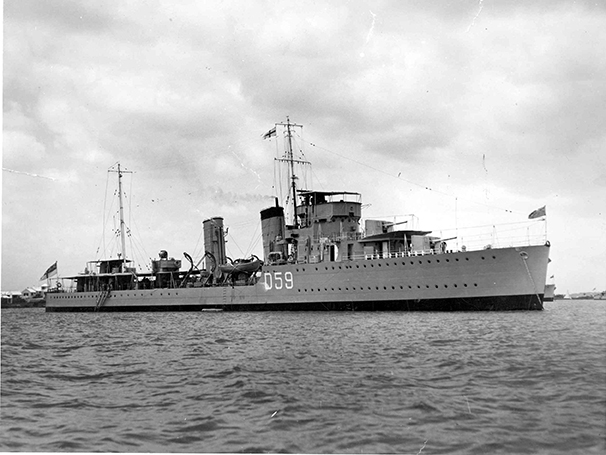HMCS Skeena
There have been two vessels named HMCS Skeena in the Royal Canadian Navy.
HMCS Skeena (1st of name) (D59 / H43 / I59)
Commissioned at Portsmouth, UK on 10 June 1931, HMCS Skeena, based on the Royal Navy A Class destroyer design, was one of the first two ships built to Canadian order. She arrived at Halifax on 3 July and proceeded to Esquimalt the following month. HMCS Skeena returned to Halifax in April 1937, and with the outbreak of war engaged in local escort duties until ordered to the UK. On her arrival at Plymouth, on 31 May 1940 she was assigned to Western Approaches Command, taking part in the evacuation of France and escorting convoys in British waters. She later joined Newfoundland Command, Mid-Ocean Escort Force (MOEF), then EG C-3 and saw continuous convoy duty. On 31 July 1942 while escorting convoy ON.115, she shared with HMCS Wetaskiwin in the sinking of U 588. She was present on D Day but on 25 October dragged her anchors in a storm and was wrecked on Videy Island, near Reykjavik, Iceland losing fifteen of her complement.
- Builder: John I. Thornycroft & Co. Ltd., Southampton
- Date laid down: 14 October 1929
- Date launched: 10 October 1930
- Date commissioned: 10 June 1931
- Date paid off: 25 October 1944
- Armament: Four 4.7-inch guns, eight 21-inch torpedo tubes
- Modified to: Two 4.7-inch guns, one 3-inch, four 21-inch torpedo tubes, six 20-mm, Hedgehog
HMCS Skeena (2nd of name) (207)
Built at Burrard Dry Dock, Vancouver, HMCS Skeena, a St. Laurent Class destroyer, was commissioned on 30 March 1957. On 14 August 1965, after a year's work at Davie Shipbuilding, Lauzon, she was re-commissioned in DDH (helicopter-carrying) format and allocated for service out of Halifax. In 1972 she was designated a French Language Unit. Along with HMCS Fraser and HMCS Protecteur, she provided security, rescue crews and emergency support at the Montreal Olympics of 1976. HMCS Skeena underwent her Destroyer Life Extension refit at Montreal between 12 April and 20 November 1981. After steaming more than 980,000 nautical miles, the venerable Cold War veteran of Canadian sovereignty patrols, officer training, countless national and international exercises and operations was paid off on 1 November 1993.
- Builder: Burrard Dry Dock Co. Ltd., Vancouver, BC
- Date laid down: 1 June 1951
- Date launched: 19 August 1951
- Date commissioned: 30 March 1957
- Date commissioned after conversions to DDH: 14 August 1965
- For DELEX: 1981
- Date paid off: 1 November 1993
- Armament: One 3-inch gun, one Limbo mortar, six 21-inch torpedo tubes and one Sea King helicopter
Motto: Go Forth
Battle honours
- Atlantic 1942-1944
- Normandy 1944
- Biscay 1944


